1993 CHEVROLET CAMARO fuel pressure
[x] Cancel search: fuel pressurePage 12 of 358
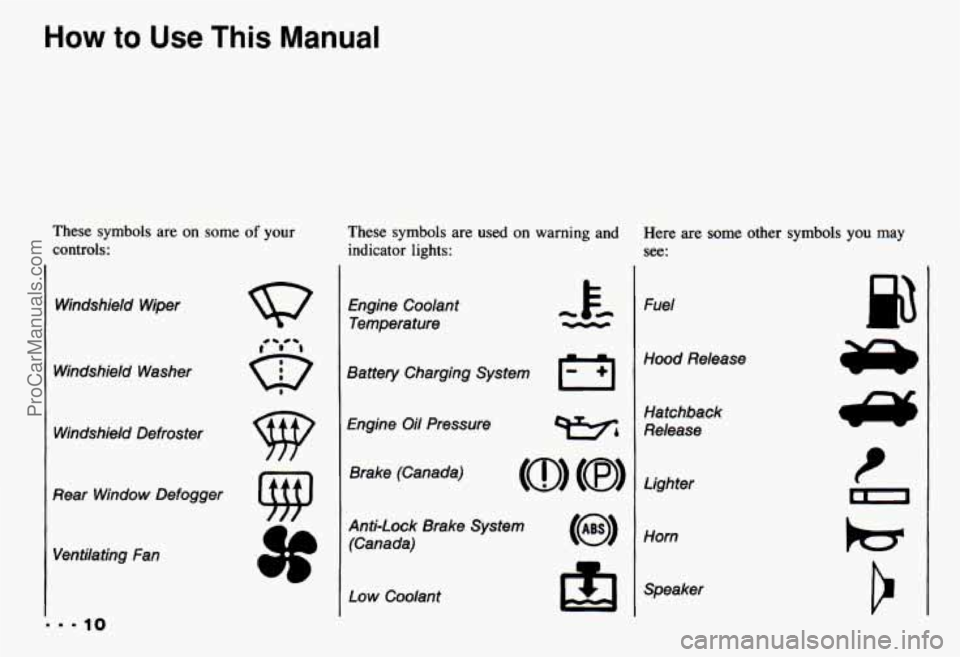
How to Use This Manual
These symbols are on some of your
controls: These symbols are used
on warning and
indicator lights:
Windshield Wiper
Windshield Washer Windshield Defroster
0
9
0-
I
Rear Window Defogger Ventilating Fan Engine Coolant
Temperature
Battery Charging System
El
Engine Oil Pressure Brake (Canada)
Anti-Lock Brake System (Canada)
Low Coolant h
Here are some other symbols you may
See:
Fuel
Hood Release
Hatchback
Release
Lighter
Horn
Speaker
p3
ProCarManuals.com
Page 14 of 358
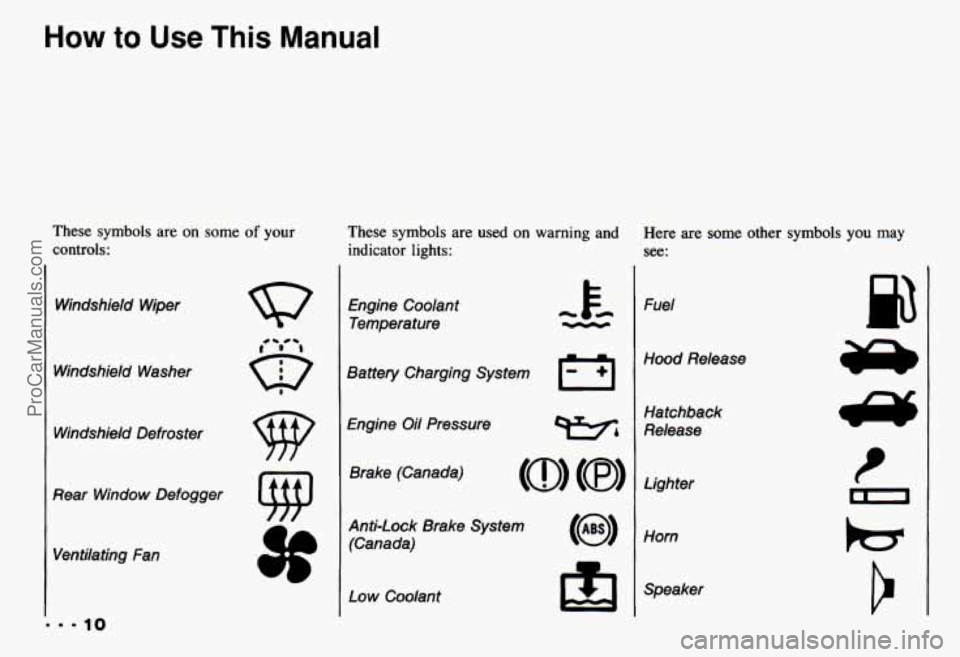
How to Use This Manual
These symbols are on some of your
controls: These symbols are used
on warning and
indicator lights:
Windshield Wiper
Windshield Washer Windshield Defroster
0
9
0-
I
Rear Window Defogger Ventilating Fan Engine Coolant
Temperature
Battery Charging System
El
Engine Oil Pressure Brake (Canada)
Anti-Lock Brake System (Canada)
Low Coolant h
Here are some other symbols you may
See:
Fuel
Hood Release
Hatchback
Release
Lighter
Horn
Speaker
p3
ProCarManuals.com
Page 108 of 358
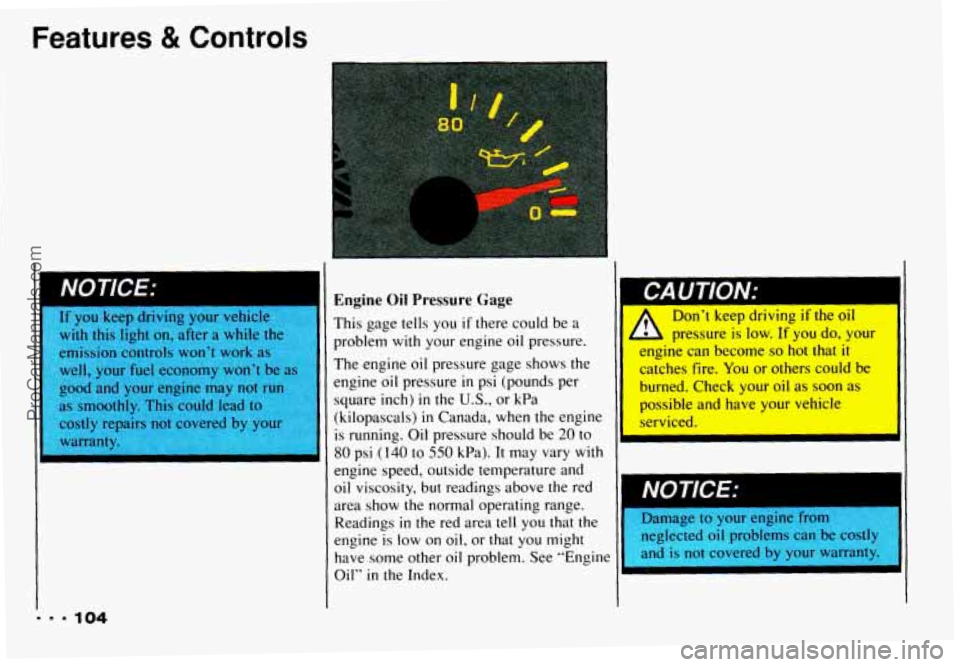
Features & Controls
It you keep driving your vehicle
with this
fight on, after a while
emission controls won’t work
well, your fuel economy won’t be
good and your engine may
not rul
as smoothly. This could lead tc
costly repairs not covered by y
warranty.
... 104
Engine Oil Pressure Gage
This gage tells you if there could be a
problem with your engine oil pressure.
The engine oil pressure gage shows the
engine oil pressure
in psi (pounds per
square inch)
in the U.S., or kPa
(kilopascals)
in Canada, when the engine
is running. Oil pressure should be 20 to
80 psi (140 to 550 kPa). It may vary with
engine speed, outside temperature and
oil viscosity, but readings above the red
area show the normal operating range.
Readings
in the red area tell you that the
engine is
low on oil, or that you might
have some other oil problem. See “Engine
Oil”
in the Index.
Don’t keep driving if the oil
h pressure is low. If you do, your
cllgine can become
so hot that it
I catches fire. You or others could be
burned. Check your
oil as soon as
possible and have your vehicle
serviced.
I NOTICE:
‘I
3
Damage your engine from
neglected oil problems can be costl)
ProCarManuals.com
Page 167 of 358

Driving a Long
Distance
Although most long trips today are made
on freeways, there are
still many made on
regular highways.
Long-distance driving on freeways and
regular highways
is the same in some
ways. The
trip has to be planned and the
vehicle prepared, you drive at
higher-than-city speeds, and there are
longer turns behind the wheel. You’ll
enjoy your trip more
if you and your
vehicle are
in good shape. Here are some
:ips for a successful long trip.
Before Leaving on a Long Trip
Make sure you’re ready. Try to be well
rested. If you must start when you’re not
fresh
- such as after a day’s work -
don’t plan to make too many miles that
first part of the journey. Wear comfortable
clothing and shoes you can easily drive
in.
Is your vehicle ready for a long trip? If
you keep
it serviced and maintained, it’s
ready to go. If
it needs service, have it
done before starting out. Of course, you’ll
find experienced and able service experts
in Chevrolet dealerships all across North
America. They’ll be ready and willing to
help
if you need it. Here
are some things you can check
before a trip:
0
0
0
0
0
Windshield Washer Fluid: Is the
reservoir
full? Are all windows clean
inside and outside?
Wiper Blades: Are they in good
shape?
Fuel, Engine Oil, Other Fluids:
Have you checked all levels?
Lights: Are they all working? Are the
lenses clean?
Tires: They are vitally important to a
safe, trouble-free trip.
Is the tread
good enough for long-distance
driving? Are the tires all inflated to
the recommended pressure?
163 -
ProCarManuals.com
Page 252 of 358

Service & Appearance Care
Headlights
Headlight Aiming
Your vehicle has a mini-quad headlight
system. These headlights have vertical
and horizontal indicators. When the
headlights are properly installed and
adjusted, and the vehicle is on level
ground, both indicators will read in the
center of the gage. If they do not, you can
adjust the aim.
A
To adjust the aim of your headlights:
1. Move your vehicle to a level surface.
Use a spirit level to be sure. Be sure
to remove any items that are not part
of your original equipment from the
trunk and passenger areas.
No one
should be seated in the vehicle and
your fuel tank should be about half
full. Check to be sure your tires are
at the correct pressure. There
are four headlights. Each one
has its own vertical and horizontal
aim position indicator. Each indicator
has its own aiming screw.
A. Vertical Indicator
B. Horizontal Indicator
C. Vertical Aiming Screw
D. Horizontal Aiming Screw
ProCarManuals.com
Page 259 of 358
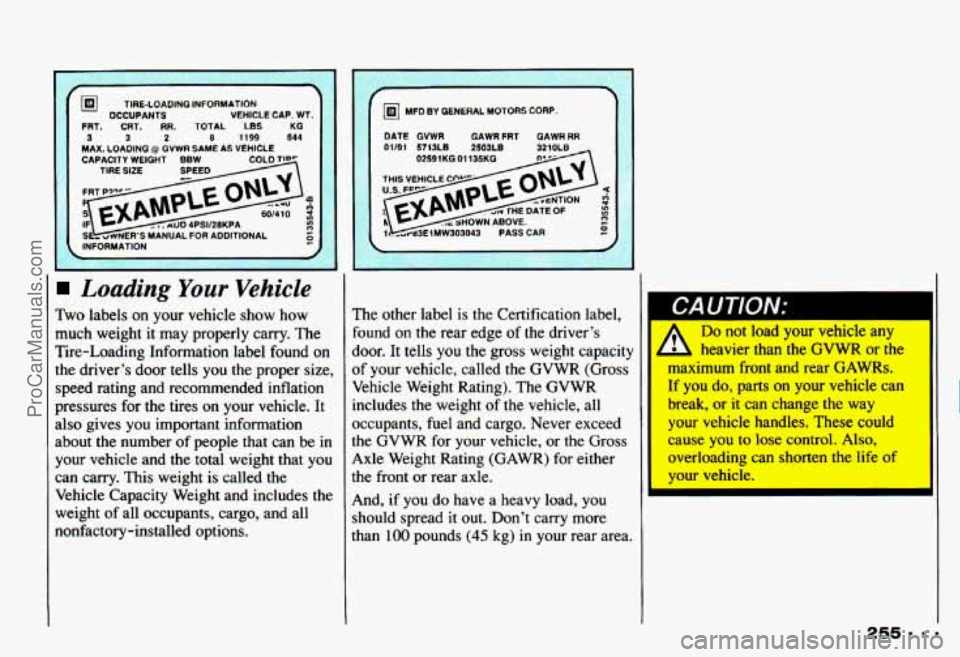
CAPACITY WEIGHT BBW TIRE SIZE
INFORMATION
Loading Your Vehicle
Two labels on your vehicle show how
much weight it may properly carry. The
Tire-Loading Information label found on
the driver’s door tells
you the proper size,
speed rating and recommended inflation
pressures for
the tires on your vehicle. It
also gives you important information
about the number of people that can be in
your vehicle and the total weight that
you
can carry. This weight is called the
Vehicle Capacity Weight and includes the
weight of all occupants, cargo, and all
nonfactory-installed options.
DATE GVWR GAWRFRT GAWR RR 01/91 5713LB ZS03LB <. .
v)
The other label is the Certification label,
found on
the rear edge of the driver’s
door. It tells you the gross weight capacity
of your vehicle, called the GVWR (Gross
Vehicle Weight Rating). The GVWR
includes the weight of the vehicle, all
occupants, fuel and cargo. Never exceed
the GVWR for your vehicle,
or the Gross
Axle Weight Rating (GAWR) for either
the front or rear axle.
And,
if you do have a heavy load, you
should spread it out. Don’t carry more
than
100 pounds (45 kg) in your rear area.
Do not load your vehicle any
- L heavier than the GVWR or the
maximum front and rear GAWRs.
If you do, parts on your vehicle can
break, or
it can change the way
your vehicle handles. These could
cause you to lose control.
Also,
overloading can shorten the life of , ,
II
ProCarManuals.com
Page 261 of 358
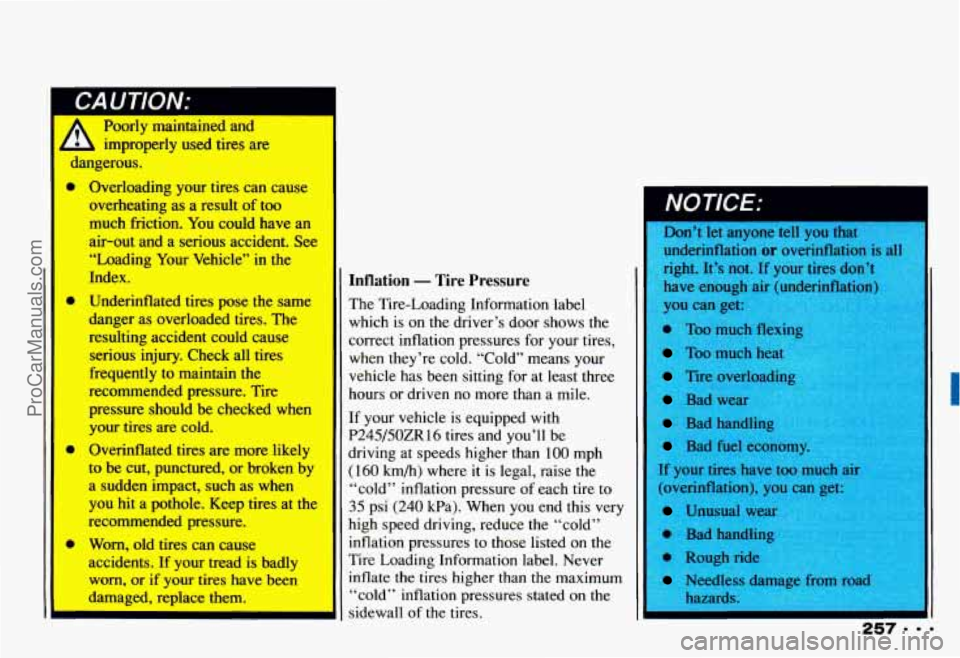
CAUTION:
Poorly maintained and
improperly used tires are
dangerous.
a
m
a
Overloading your tires can cause
overheating as
a result of too
much friction. You could have
an
air-out and a serious accident. See
“Loading Your Vehicle” in the
Index.
Underinflated tires pose the
same
danger as overloaded tires. The
resulting accident could cause
serious
injury. Check all tires
frequently to maintain the
recommended
pressure. Tire
pressure should
be checked when
your tires are cold.
Overinflated tires
are more likely
to be cut, punctured, or broken by
a sudden impact, such as when
you
hit a pothole. Keep tires at the
recommended pressure.
Worn, old tires can cause
accidents.
If your tread is badly
worn, or if your tires have been
damaged, replace them.
I
Inflation - Tire Pressure
The Tire-Loading Information label
which
is on the driver’s door shows the
correct inflation pressures for your tires,
when they’re cold. “Cold” means your
vehicle has been sitting for at least three
hours or driven no more than a mile.
If your vehicle is equipped
with
P245/50ZR16 tires and you’ll be
driving at speeds higher than
100 mph
(160 km/h) where it is legal, raise the
“cold” inflation pressure of each tire to
35 psi (240 kPa). When you end this very
high speed driving, reduce the “cold”
inflation pressures to those listed on the
Tire Loading Information label. Never
inflate the tires higher than the maximum
“cold” inflation pressures stated on the
sidewall of the tires. Don’t let anyone tell
you that
underinflation
or overinflation is all
right. It’s not.
If your tires don’t
haveenougha
n)
you can get
e Too muc
Too much heal
Tire overloading
Bad wear
Bad handli
Bad fuel econ
I If your tires have too much air
(overinflation), you
can get’
Unusual wear
’ 0 Bad handling
e Rough ri,,
Needless damage fi~111
hazards.
~
I
ProCarManuals.com
Page 339 of 358
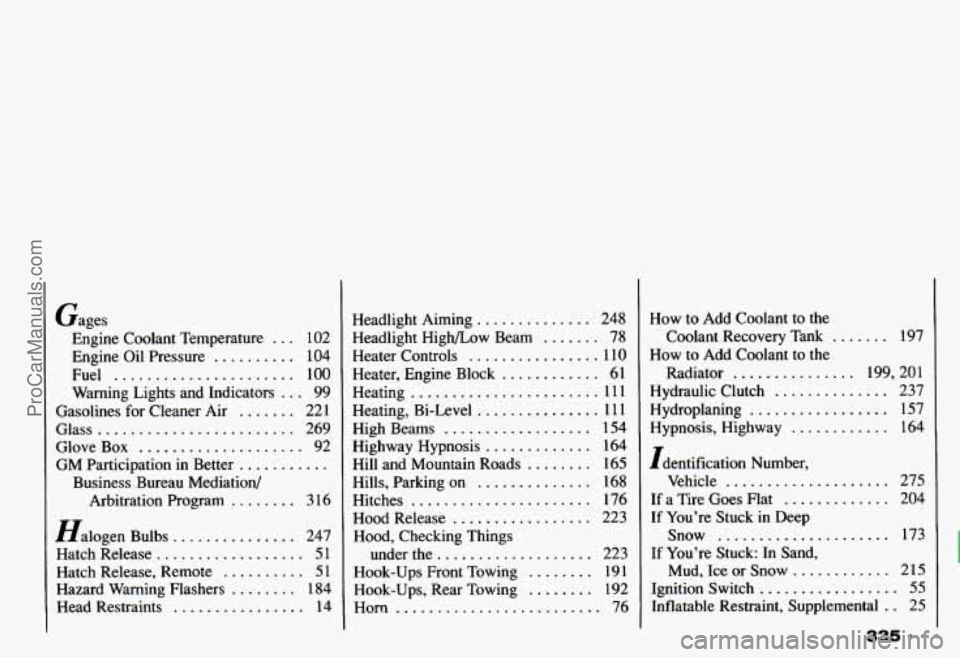
Gages Engine Coolant Temperature
... 102
Engine Oil Pressure .......... 104
Fuel ...................... 100
Warning Lights and Indicators ... 99
Gasolines for Cleaner Air ....... 221
Glass ........................ 269
Glove Box .................... 92
GM Participation in Better ...........
Business Bureau Mediation/
Arbitration Program
........ 3 16
Halogen Bulbs ............... 247
Hatch Release .................. 51
Hatch Release. Remote .......... 51
Hazard Warning Flashers ........ 184
Head Restraints ................ 14
Headlight Aiming .............. 248
Headlight Highbow Beam ....... 78
Heater Controls ................ 110
Heater. Engine Block ............ 61
Heating ....................... 11 1
Heating. Bi-Level ............... 111
High Beams .................. 154
Highway Hypnosis ............. 164
Hill and Mountain Roads ........ 165
Hills. Parking on .............. 168
Hitches ...................... 176
Hood Release ................. 223
Hood. Checking Things
under the
................... 223
Hook-Ups Front Towing ........ 19 1
Hook-Ups. Rear Towing ........ 192
Horn ......................... 76
How to Add Coolant to the
Coolant Recovery Tank
....... 197
How to Add Coolant to the
Radiator
............... 199. 201
Hydraulic Clutch .............. 237
Hydroplaning ................. 157
Hypnosis. Highway ............ 164
Identification Number.
Vehicle
.................... 275
If a Tire Goes Flat ............. 204
If You’re Stuck in Deep
Snow
..................... 173
If You’re Stuck: In Sand.
Mud. Ice or Snow ............ 215
Ignition Switch ................. 55
Inflatable Restraint. Supplemental . . 25
335 . .
ProCarManuals.com